The History of the Cunard Line from 1884
RMS Umbria and RMS Etruria (1884)
With size, power and speed all improved, the fast turn-arounds, meant only four ships would be needed to service the main Atlantic route. Once this target was met, designers aimed at three ships to do the work of four. The ultimate prize was a weekly Atlantic service maintained by two large and fast ships. This evolved into the Queens.
The Blue Riband stirred public interest for the next three quarters of a century; to be the winner held great prestige and value. The speed record was often broken by different lines. The record began to pass from ship to ship and in some cases at monthly intervals. Some passages began to be measured in hour and minutes, as well as days. The Cunard Line never formally recognised the Blue Riband. The owners did not like the “race track” mentality and thought that it could interfere with the principles of safety. Only if the Blue Riband was won through normal sailing, would it then be a valuable advertising point for the company.
The Umbria and the Etruria were built in 1884 by John Elder & Co at Glasgow. They were the first Cunard “18 knot ships” produced since the reorganisation of the company. Their accommodation aimed at taking away to sea essentials to Victorian living: heavy ornamented furniture and panelling, profusion of velvet drapes, and in the music room there were stained glass cupolas, an organ and a piano.
They were floating hotels of their day. Below decks, the passenger accommodation was fine. The specifications of the ships exceeded the conditions of insurance as laid down by Lloyds. The ship was constructed with watertight bulkheads, fireproof doors and two sets of steering gears. All modern safety features of her day were installed. They were quite extraordinary ships.
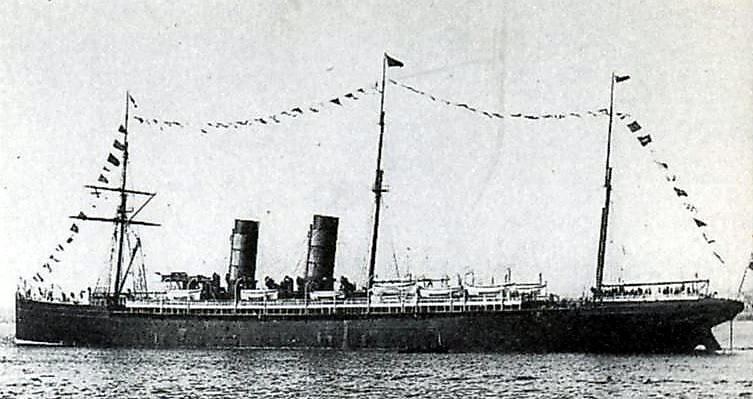
The Umbria was built at Glasgow and was launched on 26 June 1884. She was 501.6 feet long with a beam of 57.2 feet. The ship had two funnels, three masts rigged for sail and could maintain a speed of 19 knots. Initially, the Umbria had capacity for 550 First Class and 800 Second Class passengers but her refit in 1892 restructured her capacity to accommodate 500 First Class, 160 Second Class and 800 Third Class passengers.
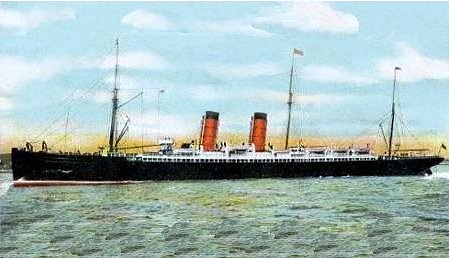
The Etruria was launched on 20 September 1884 and her maiden voyage commenced on 25 April 1885. She was 501.6 feet long with a beam of 57.2 feet and had a gross tonnage of 7,718. The Etruria was almost identical to her sister, Umbria and she could carry the same passenger capacity before and after her refit in 1892. In May 1888, the Etruria gained the Blue Riband and held it for a year before the Inman Line’s City of Paris took it away from Cunard.
RMS Campania (1892) and RMS Lucania (1893)
In 1890, Cunard celebrated its 50th anniversary and planned to build two big ships. In August 1891, a contract was signed between Fairfield Shipbuilding and Engineering Co and Cunard to build the Campania and the Lucania. They were driven by improvements to the reciprocating engine.
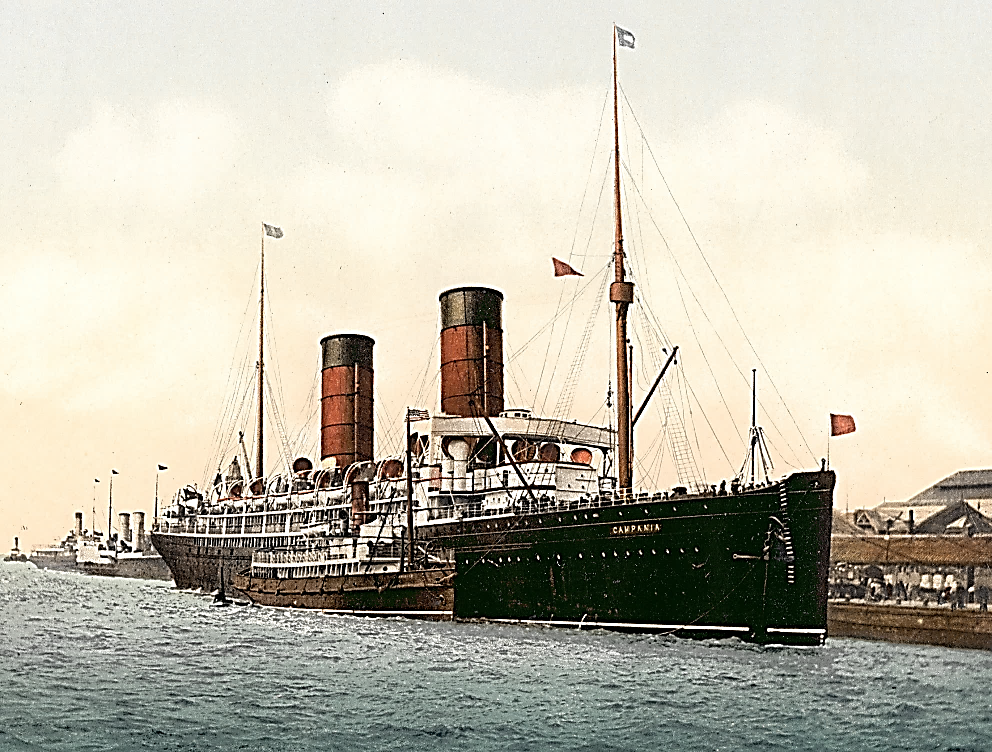
The Campania’s hull was laid down on 22 September 1891 and launched on 8 September 1892. She was 622 feet long with a beam of 65.3 feet and had a gross tonnage of 12,950. The Campania was the first twin screw Cunarder that could maintain a speed of 22 knots and had the largest triple-expansion engines ever fitted to a Cunard ship.
The liner could accommodate 1806 passengers: 526 First Class, 280 Second Class and 1,000 Third Class (or Steerage). She had a crew of 415. On 22 April 1893, the Campania commenced her maiden voyage from Liverpool to New York. Until 1897, the Campania and the Lucania were the largest ships in the world.
In August 1894, the Campania crossed the Atlantic westbound in record time of 5 days, 9 hours and 29 minutes and won the Blue Riband. She averaged 21.49 knots. The Campania held the eastbound record between May 1893 and May 1894 in a time of 5 days, 17 hours and 27 minutes.
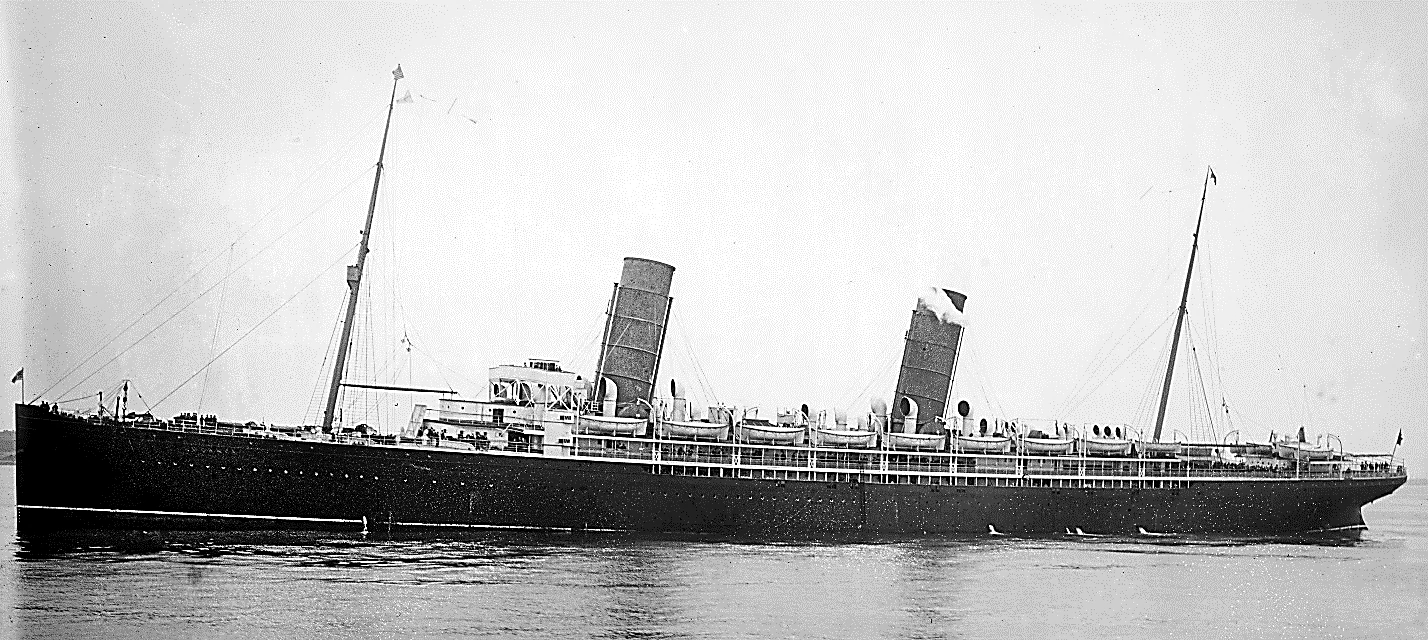
The Lucania had the identical tonnage and dimensions of her sister, Campania. She was launched on 2 February 1893 and commenced her maiden voyage on 2 September 1893. The Lucania held the westbound record for the Blue Riband from October 1893 to August 1894 with a time of 5 days, 13 hours and 45 minutes averaging 20.75 knots and broke the record again in August 1894, September 1894 and October 1894. Her best recorded westbound time was 5 days, 7 hours.
On 15 June 1901, the Lucania became the first Cunarder to be fitted with a Marconi Wireless system which provided passengers with a daily newspaper, the “Cunard Bulletin” and wireless messages from Marconi stations in Nova Scotia and England.
The Cunard Passenger Log Book 1894
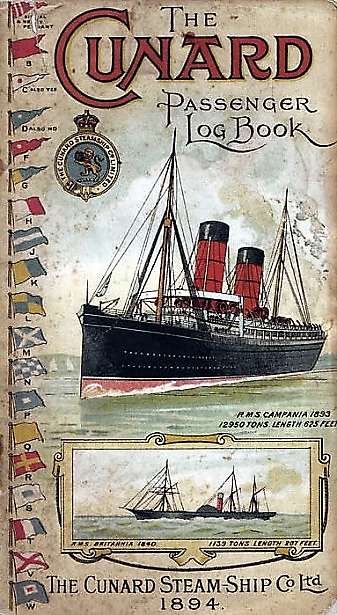
Both ships offered the most luxurious First Class passenger accommodation. The Cunard Passenger Log Book of 1894 described the luxurious accommodation of the Campania and Lucania.
“Staterooms: The profusion of small shelves, trinket drawers, book racks, etc., in the state rooms certainly suggest that the designer had an intimate knowledge of the essential requirements of passengers especially of ladies, whose love of cupboards, etc... is almost proverbial. There is a large wardrobe in each room, and, of course, the usual wash stand, life-belt, racks, hooks, etc. The general rooms are fitted in mahogany, and upholstered with plush or velvet, while the fittings are electro-plated. Electric light and electric call bells add to the very complete sum of comfortable surroundings.
There are rooms to suit all tastes in the ship. A large number of single berth cabins are, as we have said, provided, and many double cabins, together with several three or four berth rooms, while family apartments are provided in addition to magnificently appointed suites on the Upper Deck. Several of these en-suite rooms are fitted in the most beautiful satinwood and mahogany. They are arranged as parlour and bedroom, the parlour being fitted with table, couch, and chair, on the model of a lady's boudoir, with suitable decorations.
In the bedroom is a handsome brass-furnished bedstead with over-hangings. There are toilet arrangements in the most excellent style, with all the etcetera’s desirable. While these suites of rooms will form the highest attraction, there are, on the same deck, a large number of superior rooms, although not associated with the same luxuries. They are fitted on the lines of the better class of state rooms, but panelled in hardwood instead of being painted, and supplied with patent collapsible bedsteads. The bedstead is capable of being extended to form a double bed, and when a single bed the front rail may be collapsed to form a couch or settee.
Second Class Passenger Accommodation: The public rooms for the Second Class passengers are all placed abaft the machinery on the upper arid promenade decks. Almost the only difference between the fittings of the First and Second Class cabins and state rooms is in the use of brass mountings instead of electro-plate, and possibly there is a larger number of four-berth rooms. In all respects the accommodation and convenience are practically the same.
Steerage Accommodation: The Steerage passengers, of whom from 600 to 1,000 may be carried, are accommodated on the lower deck. Iron portable berths are provided. These passengers will be allowed to promenade on upper deck, the circuit of which five times makes a one-mile walk, so that, in this respect, they are very favourably situated. Each compartment of the steerage has a pantry for the special use of the passengers located therein.”
The Lucania, Campania and Ultonia were built in the 1890s; the Ivernia and Saxonia were commissioned in 1899.
In June 1897, Sir Charles Algernon Parsons, inventor of the compound steam turbine, demonstrated the great potential of his engine on his yacht, Turbinia at Portsmouth. Cunard wanted to determine which type of engine would be more economical and practical for large passenger ships other than existing engines found in older Cunarders.
RMS Caronia (1904) and RMS Carmania (1905)
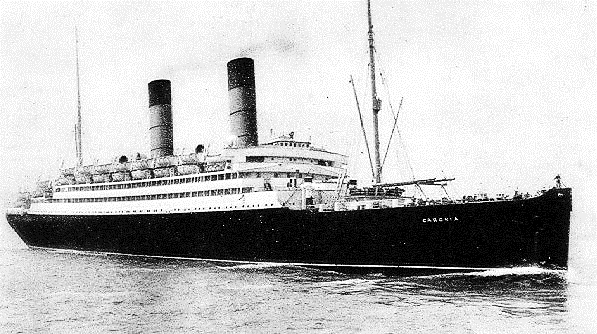
Cunard commissioned the “pretty sisters,” the Caronia and the Carmania and each would trial a different type of engine. The Caronia would trial a quadruple expansion engine and the Carmania would have a turbine driven engine. On their trials, the Carmania averaged 20.4 knots and the Caronia averaged 19 knots.
The Caronia was built by John Brown & Co and launched on 13 July 1904. Her maiden voyage commenced on 25 February 1905 from Liverpool to New York and she continued her transatlantic service (and a winter Mediterranean service) until the outbreak of the First World War. She was identical to her sister. The Caronia could accommodate 300 First Class, 350 Second Class and 900-1100 Third Class passengers.
The Carmania was designed by Leonard Peskett and built in l904 by John Brown & Co. She was identical to her sister ship, the Caronia. The Carmania was launched on 21 February 1905 and commenced her maiden voyage on 2 December 1905. She was 650.4 feet long with a beam of 72.4 feet and had a gross tonnage of 19,524. The liner suffered a major fire in June 1910.
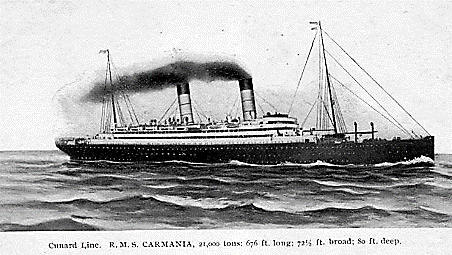
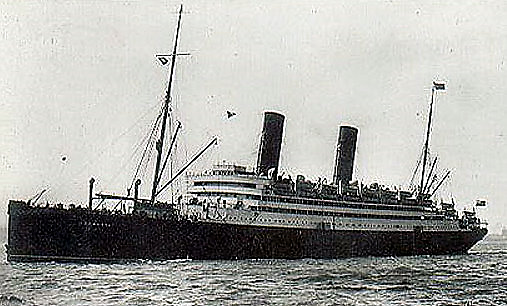
The Carmania proved beyond doubt that a turbine engine was the best form of propulsion for the giant ships on the drawing board: the Lusitania and the Mauretania.
In 1902, the International Mercantile Marine Co (IMM) was set up by John Pierpont Morgan. The IMM had swallowed many Atlantic shipping lines and had eyes on the Cunard Line. Lord Inverclyde, Cunard’s chairman at the time, understood that new, large and very fast ships would be needed to hold back competition. An outcome of negotiations was a government loan of £2,600,000 over 20 years at 2¾ per cent, which opened the way for the Mauretania and the Lusitania to be built.
